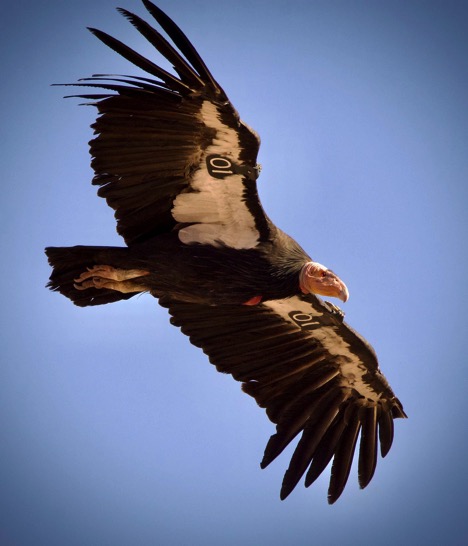
By Larry Barnes
On Sunday, Valentine’s Day 1982, a California condor soared on its broad wings high above Sespe Condor Refuge in Southern California. To the north, the bird could see the endless agricultural lands of the San Joaquin Valley and to the south, the air pollution hanging over the L.A. sprawl. As seen through a 60-power Questar telescope, the condor was a tiny dot, flying with an even smaller speck, a prairie falcon, both rising on a shared thermal to higher elevations. For the condor, its future as an extant species on Earth was gravely uncertain.
These are my memories from 41 years ago upon seeing my first condor. At the time only 27 remained. Twenty-two were wild and free, roaming the last corner of their range in a broad U-shaped territory just north of Los Angeles. Five years later all had been captured in a last ditch attempt to save the species through captive breeding.
I do not know which condor I saw that day, but it could have been Adult Condor 08 (AC-8). She had hatched in the wild and was the last female to be captured in 1986. In 1987 all of Earth’s condors were in federal breeding facilities. AC-8 was held in captivity for 14 years, during which time she produced 12 eggs. In the wild, California condors produce one egg every two years, but in captivity biologists are sometimes able to increase the rate of production up to two eggs annually.
AC-8 was freed in 2000, soaring on her 9-foot wings for the first time in more than a decade. Condors are social birds and her role in the wild was to mentor the few young condors that had recently been reintroduced into the wild. She was wild and free again, but in December 2003, AC-8 was recaptured, treated for lead poisoning, but released once more. She cruised her former range, perhaps as high as 20,000 feet at 80 mph, alert to the odor of some freshly dead mammal or the sight of turkey vultures, golden eagles, or other condors that had already found carrion to eat.
On Feb. 8, 2003, Britton Cole Lewis, age 29, was pig hunting on a Kern County ranch when he saw a condor for the first time. Taking aim, he shot AC-8 out of a tree. She was between 30 and 40 years old at the time of her killing.
During the Pleistocene, California condors had a range extending to Florida, but as the large megafauna disappeared, the condor’s range shrank to the Pacific Coast from the Columbia River, where Lewis and Clark saw them in 1805, to Baja California. Here they occurred in low densities, finding recently dead mammals to eat, including whales and other marine life.
Their decline abruptly increased with the arrival of Europeans, who, like Britton Cole Lewis, found them tempting targets. In our chemical warfare against predators, poisoned carcasses intended for coyotes killed condors as well. The electrification of the West took another share of condors when the birds were electrocuted when perching on power poles. Some of these obstacles to condor recovery are greatly reduced now, but one remains.
Ingesting lead can be lethal to people and condors. A lead bullet entering an animal disintegrates, creating a contaminated wound channel of tiny toxic lead fragments. California has banned lead ammunition, but the National Rifle Association is opposed to this measure. Lead is certainly still being used in California, Utah and Arizona, where reintroduced condors now fly free. Copper bullets, the lead alternative, are as lethal as lead bullets, but safe if ingested.
What does it mean to be wild? Almost 600 California condors are living today, over 350 of them are flying free in three U.S. states and Baja, California; most are tagged with visible numbers and many have solar-powered GPS units fastened to their bodies. Much of the wild population is routinely recaptured to assess their health. If their lead levels are dangerously high, they receive chelation treatment and are released upon recovery. Some populations have feeding stations where they can reliably find lead-free carrion. So, are they still wild?
Recently, at the Navajo Bridges in Grand Canyon, I watched condors interact with each other, preen, curiously watch people, and navigate through the skies and invisible thermals in any direction they wished. Regardless of what we think, it was easy to imagine that the condors themselves do feel wild and free.


